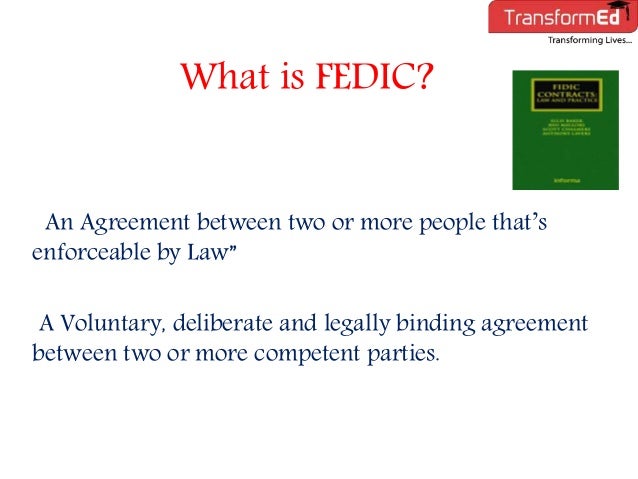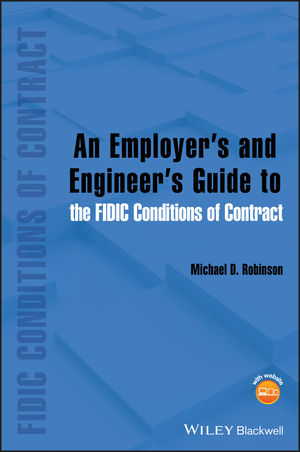Fidic Contracts Guide
FIDIC is the International Federation of Consulting Engineers, known by its French acronym. It was formed in 1913, with the objective of promoting the interests of consulting engineering firms globally. It is best known for its range of standard conditions of contract for the construction, plant and design industries. The FIDIC forms are the most widely used forms of contract internationally, including by the World Bank for its projects. This guide will look at the Red and Yellow Books under the FIDIC Suite of New Contracts. What is the FIDIC family of contracts? The FIDIC 'Rainbow Suite' of New Contracts was published in 1999 and includes:. the Red Book: Conditions of Contract for Construction for Building and Engineering Works Designed by the Employer;.
the Yellow Book: Conditions of Contract for Plant and Design-Build;. the Silver Book: Conditions of Contract for EPC/Turnkey Projects;. the Green Book: Conditions of Short Form of Contract. These 'new' forms were first editions and designed to be user-friendly, with a standardised approach and a reduction in the general conditions from over 60 to 20 clauses. Additional forms in use since 1999 include:.

the Blue Book: Contract for Dredging and Reclamation Works;. MDB/FIDIC Contract: FIDIC conditions incorporated in the standard bidding documents of multilateral development banks;. the White Book: Client/Consultant Model Services Agreement;. the Gold Book: FIDIC Design, Build and Operate Projects.
Fidic Construction Contract
To assist with implementing its founding objectives, FIDIC's approach to drafting contracts has always been underpinned by the principle that its contracts must provide a fair allocation of risks between the parties to a contract, and that risks should be borne by the party best able to control them. Understanding the contract and general provisions The Red and Yellow Books have a similar structure, with 20 general conditions. Both have guidance to assist in the preparation of particular conditions, and also the option to add Particular Conditions. The Red Book (the Construction Contract for Building and Engineering Works Designed by the Employer) is intended to be used where the employer is responsible for the design of the works. It is a re-measurement contract, meaning that the employer and the contractor will agree in their contract the rates for types of work and those rates will be applied to the quantity of that work that the contractor carries out. The employer takes the risk that the quantities it estimates will be more or less accurate, while the contractor must ensure that its unit prices for the quantities are adequate.
The Yellow Book (the Plant and Design-Build Contract) is intended for use where the works are designed by the contractor. It is a lump sum contract, in which the contractor promises to deliver the project for a set price. The contractor, therefore, takes the risk of quantities. All FIDIC books define the role of the engineer essentially as the agent of the employer.
The engineer is primarily responsible for contract administration. The engineer:. issues instructions and notices;.
monitors the works;. acts as certifier. Note that the engineer is no longer stated to be impartial - in the Red and Yellow Books the engineer is deemed to and in practice does act for the employer. The contractor's main obligation under any construction contract is of course the construction and completion of the works within the specified time for completion and in accordance with the contract. Its other obligations under the Red and Yellow Books include:. fitness for purpose – ensuring that its design will meet the employer's requirements;. design responsibility;.
carrying out the works in a proper and workmanlike manner with properly equipped facilities and non-hazardous materials;. providing those facilities and choosing those materials;. responsibility for method of working. The contractor also has an obligation to perform certain administrative and other functions to facilitate performance, including providing information needed for the execution and completion of the works and the issuing of notices including for events increasing cost or completion time. How to avoid pitfalls Contractor's claims: a key obligation under the Red and Yellow Books is the requirement to serve notice in respect of a claim for an extension of time or additional payment.
The contractor must give notice of its intention to claim as soon as possible and no later than 28 days after the contractor becomes aware, or should have become aware, of an event. It must then submit its fully detailed claim within 42 days of becoming aware of an event or circumstance that gives rise to a claim. Previously, failure to comply with these time limits meant that any compensation would be limited to sums supported by contemporary records. Now, there is no entitlement to compensation if the contractor fails to comply. Variations and adjustments: using the Red and Yellow Books, a variation for changes to the works can arise by:.
an employer's instruction;. an employer's request for a proposal;. a contractor's 'value engineering' proposal.
Variations may have an adverse impact on the contract or on the guarantees in place for the project, for example through a reduction in the safety or suitability of the works. This should be monitored and flagged up immediately. A contractor could have liability even where it is simply following the engineer's instructions. A contractor is obliged to comply with the employer's request for a variation unless it cannot readily obtain the necessary goods required for that variation. One issue to be aware of is whether the engineer's suggestions can be deemed to be variations.
This will be determined by the facts of a particular event. The Red and Yellow Books provide that if the engineer gives an oral instruction and the contractor confirms that instruction in writing within two working days then, if the engineer does not reject this confirmation within two working days, that confirmation is deemed to constitute a written instruction of the engineer. It is therefore very important to ensure that any verbal instruction that changes the scope of the works is confirmed in writing. The contractor should not make alterations or modification to the works unless instructed or approved by the engineer. Delay and extension of time: the contractor will be liable for damages if the actual completion date of the works occurs after the agreed completion date unless the delay is caused by a matter for which an extension of time is available and the contractor complies with the notice and other requirements under the contract.

The contractor may be entitled to an extension of time where there is:. a variation or additional work instructed;. exceptionally adverse weather;. unforeseeable shortages in the availability of personnel or goods;. delay caused by the employer;. a cause of delay under any other clause in the contract;. unforeseeable delay caused by complying with public authority procedures.
The contractor must strictly comply with the notice requirements under the contract, including giving all necessary information required in relation to the claim. Note that minutes of a meeting or a contractor's progress report are unlikely to constitute proper notice. Dispute resolution Disputes under Red and Yellow Book contracts should be referred to a Dispute Adjudication Board (DAB). A DAB can be created at the start of the project or when a dispute occurs. It is an informal process which encourages party involvement and recognises the need for speed.
The contracts provide that a DAB's decision will become final and binding 28 days after it is issued if the parties do not give a notice of dissatisfaction. Where a notice of dissatisfaction is given, the parties are obliged to attempt the amicable settlement of their disputes. Unless such disputes are settled amicably, any dispute in respect of which the DAB's decision has not become final and binding will be settled by international arbitration. The importance of record-keeping Keeping adequate records is essential to:. establish entitlements to money and time;.
defend subcontractor claims;. comply with the contract's reporting obligations. Decide at the outset how and what records should be kept, ensuring of course that this also complies with the contract. There is no point putting in place an unnecessarily detailed or complex procedure that your administrative or site team will be unable to follow. Summary The effective administration of a FIDIC construction contract is essential to ensure that time and money claims are protected. It is important to write notices in clear and unequivocal terms – do not hint or insinuate. Keeping effective records will assist contractors and employers to prove their entitlements and enable both parties to accurately ascertain their positions in the event that a dispute arises.
FIDIC has long been renowned for its standard forms of contract for use between employers and contractors on international construction projects, in particular:. Conditions of Contract for Works of Civil Engineering Construction: The Red Book (1987).
Conditions of Contract for Electrical and Mechanical Works including Erection on Site: The Yellow Book (1987). Conditions of Contract for Design-Build and Turnkey: The Orange Book (1995) During its past work in updating the Red and Yellow Books, FIDIC has noted that certain projects have fallen outside the scope of the existing Books. Accordingly FIDIC has not only updated the standard forms but has expanded the range, and has - in September 1999 - published a suite of four new Standard Forms of Contract which are suitable for the great majority of construction and plant installation projects around the world. Answer the following questions: A. Relatively small value, short construction time or involving simple or repetitive work. If the price for the contract is relatively small, say under US$ 500,000, or the construction time is short, say less than 6 months, or the work involved is relatively simple or repetitive - dredging work might be a good example: then consider using the Short Form of Contract, which is a completely new FIDIC Book specially prepared for such projects. It does not matter whether the design is provided by the Employer (or his Engineer/Architect if he has one) or by the Contractor,.
It does not matter whether the project involves construction, electrical, mechanical, or other engineering work. Larger or more complex projects 1.
Is the Employer (or the Engineer) going to do most of the design? As in traditional projects, e.g., infrastructure, buildings, hydropower, etc., the Employer did nearly all the design (perhaps not construction details, reinforcement, etc.) (The Red Book),. and the Engineer administered the Contract, monitored the construction work and certified payment.
and the Employer was kept fully informed, could make variations, etc. and with payment according to bills of quantities or lump sums for approved work done. If this is what is wanted - choose the Conditions of Contract for Construction for Building and Engineering Works Designed by the Employer (The Construction Contract), which effectively updates and supercedes the existing Red Book from 1987. In 2005, FIDIC licenced the Multilateral Development Banks (MDB) to use the MDB Harmonised Edition of the Construction Contract for projects funded by the banks. The MDB Construction Contract mainly incorporates Particular Conditions to the Red Book that was used by the World Bank in its Standard Bidding Documents before it and the other MDBs adopted the Harmonised Edition. Is the Contractor going to do most of the design?